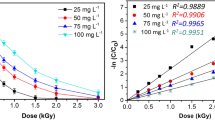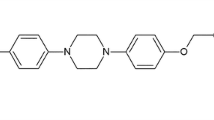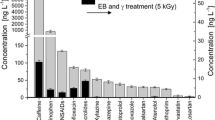Abstract
The decomposition of penicillin G and erythromycin antibiotics at concentration of 0.2 mg ml−1 by gamma irradiation at 50 kGy followed by biological treatment with Cupriavidus metallidurans CH34 was evaluated. Degradation of penicillin G and erythromycin was analyzed using nuclear magnetic resonance analysis (NMR), fourier transform infrared spectroscopy (FTIR), and chemical oxygen demand (COD). The exposure to the absorbed dose of 50 kGy caused degradation of penicillin G and erythromycin in the aqueous solution. The complete disappearance of NMR and FTIR peaks following irradiation confirmed the breakage of the β-lactam ring in penicillin G, and the decarboxylation and cleavage of the thiazolidine ring and for erythromycin, the complete destruction of the three aromatic rings. Irradiation alone removed 52.8 and 65.5 % of penicillin G and erythromycin, respectively. Further reduction to 12.6 and 14 % of the original penicillin G and erythromycin COD, respectively, was achieved using treatment of the irradiation products with C. metallidurans.





Similar content being viewed by others
References
Arslan-Alaton I, Gurses F (2004) Photo-Fenton-like and photo-fenton-like oxidation of procaine penicillin G formulation effluent. J Photochem Photobiol Sci 165:165–175
Ben Salem I, Mezni M, Errami M, Amine KM, Salghi R, Ismat HA, Chakir A, Hammouti B, Messali M, Fattouch S (2015) Degradation of enrofloxacin antibiotic under combined ionizing radiation and biological removal technologies. Int J Electrochem Sci 10:3613–3622
Bögl W (1985) Radiation sterilization of pharmaceuticals: chemical changes and consequences. Radiat Phys Chem 25:425–435
Boxall ABA, Fogg LA, Blackwell PA, Kay P, Pemberton EJ, Croxford A (2004) Veterinary medicines in the environment. Rev Environ Contam Toxicol 180:1–91
Cho JY (2010) Evaluation of degradation of antibiotic tetracycline in pig manure by electron beam irradiation. Bull Environ Contam Toxicol 84:450–453
Clara M, Strenn B, Gans O, Martinez E, Kreuzinger N, Kroiss H (2005) Removal of selected pharmaceuticals, fragrances and endocrine disrupting compounds in a membrane bioreactor and conventional wastewater treatment plants. Water Resour 39(19):4797–4807
Cooper WJ, Nickelsen MG, Meacham DE, Waite TD, Kurucz CN (1992) High energy electron beam irradiation: an innovative process for the treatment of aqueous-based organic hazardous wastes. J Environ Sci Health 27(1):219–244
Dail MK, Mezyk SP (2010) Hydroxyl-radical-induced degradative oxidation of beta-lactam antibiotics in water: absolute rate constant measurements. J Phys Chem 114(32):8391–8395
Dziegielewski J (1975) Gamma radiation decomposition yield in dehydrated and hydrated aminobenzyl penicillin and based radiation chemical processes. Radiat Phys Chem 7:507–518
Dziegielewski J, Jezowska-Trzebiatowska B, Siemion IZ, Zabza A (1974) Non-gaseous radiolysis products of 6-aminopenicillanic acid and potassium salt of benzylpenicillin. Nukleonika 19:291–301
Farre MJ, Domenech X, Peral J (2007) Combined photo-Fenton and biological treatment for Diuron and Linuron removal from water containing humic acid. J Hazard Mater 147(1):167–174
Jill B, Jeffrey IG, Luyun L, Gareth AM, David AP, James KS (1991) The structure of erythromycin A in [2H6] DMSO and buffered D2O: full assignments of the 1H and 13C NMR spectra. J Chem Soc Perkin Trans 2(10):1489–1494
Kim I, Yamashita N, Tanaka H (2009) Performance of UV and UV/H2O2 processes for the removal of pharmaceuticals detected in secondary effluent of a sewage treatment plant in Japan. J Hazard Mater 166(2–3):1134–1140
Kulik N, Trapido M, Goi A, Veressinina Y, Munter R (2008) Combined chemical treatment of pharmaceutical effluents from medical ointment production. Chemosphere 70(8):1525–1531
McArdell CS, Molnar E, Mark JFS, Giger W (2003) Occurrence and fate of macrolide antibiotics in wastewater treatment plants and in the Glatt Valley Watershed, Switzerland. Environ Sci Technol 37:5479–5486
Pulgarin C, Invernizzi M, Parra S, Sarria V, Polania R, Péringer P (1999) Strategy for the coupling of photochemical and biological flow reactors useful in mineralization of biorecalcitrant industrial pollutants. Catal Today 54:341–352
Rivera-Utrilla J, Sánchez-Polo M, Ángeles Ferro-García M, Prados-Joya G, Ocampo-Pérez R (2013) Pharmaceuticals as emerging contaminants and their removal from water. A review. Chemosphere 93(7):1268–1287
Roig B, Touraud E, Ternes T, Loeffler D, Schluesener M, Zabczynski S, Buntner D (2009) Options de mesure et d’elimination des produits pharmaceutiques dans les eaux usees europeennes: resultats du projet Europeen Knappe. Tech Hosp 06(715):57–62
Sanchez-Polo M, Lopez-Penalves J, Prados-Joya G, Ferro-Garcia MA, Rivera Ultrilla J (2009) Gamma irradiation of pharmaceutical compounds, nitroimidazoles, as a new alternative for water treatment. Water Resour 43:4028–4036
Scott JP, Ollis DF (1995) Integration of chemical and biological processes for water treatment: review and recommendations. Environ Prog 14:88–103
Song W, Cooper WJ, Mezyk SP, Greaves J, Peake BM (2008) Free radical destruction of β-blockers in aqueous solution. Environ Sci Technol 42:1256–1261
Yu S, Lee B, Lee M, Cho IH, Chang SW (2008) Decomposition and mineralization of cefaclor by ionizing radiation: kinetics and effects of the radical scavengers. Chemosphere 71(11):2106–2112
Acknowledgments
The authors wish to thank Tunisian Ministry of Higher Education and Scientific Research for supporting this work. We thank Mr Zied Trabelsi for his assistance on the gamma irradiator facility.
Author information
Authors and Affiliations
Corresponding author
Rights and permissions
About this article
Cite this article
Ben Salem, I., Mezni, M., Boulila, A. et al. Removal of Penicillin G and Erythromycin with Ionizing Radiation Followed by Biological Treatment. Curr Microbiol 73, 582–586 (2016). https://doi.org/10.1007/s00284-016-1097-6
Received:
Accepted:
Published:
Issue Date:
DOI: https://doi.org/10.1007/s00284-016-1097-6




